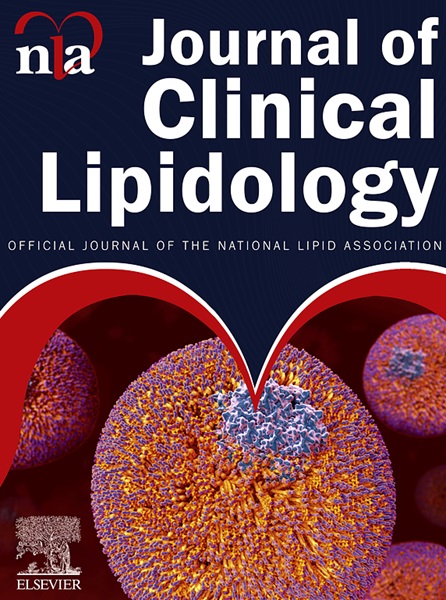高血缘人群的纯合子家族性高胆固醇血症:来自沙特队列的见解。
IF 4.6
3区 医学
Q2 PHARMACOLOGY & PHARMACY
引用次数: 0
摘要
背景:纯合子家族性高胆固醇血症(HoFH)是一种遗传性疾病,其特征是低密度脂蛋白胆固醇(LDL-C)水平显著升高,早发性心血管疾病(CVD)和过早死亡的风险显著增加。本研究探讨HoFH患者的临床特征、治疗结果、基因发现和反向级联筛查结果。方法:2010年至2023年在一家大型转诊中心随访的来自65个家庭的88例HoFH患者。通过电子病历回顾和电话访谈获得临床、遗传和结局数据。结果:88例患者中,男性占45.4%;中位年龄:17岁),LDLR突变的发现率为100%。家族史阳性者占87.5%,有血缘关系者占75%。反向级联筛查导致确定了76个额外的受影响亲属,每个家庭中位数为7人。治疗包括改变生活方式、降脂药物(79.5%)、低密度脂蛋白穿刺(29.6%)和肝移植(20.5%)。治疗结果方面,肝移植降低LDL-C最显著(降低83.3%,p < 0.001),其次是以洛米他胺为基础的治疗(降低69.4%,p = 0.004)。并发症包括黄瘤(62.5%)和CVD(38.6%),死亡率为13.6%(死亡时中位年龄:16岁),主要由心血管事件引起。结论:HoFH在沙特阿拉伯构成了一个未被充分认识的公共卫生挑战,特别是在高血缘和始祖突变的背景下。通过遗传和反向级联筛查进行早期诊断,以及积极的管理,对于提高生存率至关重要。这些发现强调了国家筛查计划和扩大先进降脂疗法的迫切需要。本文章由计算机程序翻译,如有差异,请以英文原文为准。
Homozygous familial hypercholesterolemia in a high-consanguinity population: Insights from a Saudi cohort
BACKGROUND
Homozygous familial hypercholesterolemia (HoFH) is a genetic disorder characterized by markedly elevated low-density lipoprotein cholesterol (LDL-C) levels and a significantly increased risk of early-onset cardiovascular disease (CVD) and premature death. This study investigates the clinical features, treatment outcomes, genetic findings, and reverse cascade screening results for HoFH patients.
METHODS
A total of 88 HoFH patients from 65 families following at a large referral center between 2010 and 2023 were included. Clinical, genetic, and outcome data were obtained through electronic chart review and phone interviews.
RESULTS
Among the 88 patients (45.4% males; median age: 17 years), LDLR mutations were identified in 100%. Positive family history and consanguinity were reported in 87.5% and 75% of patients, respectively. Reverse cascade screening led to the identification of 76 additional affected relatives, with a median of 7 individuals per family. Treatment included lifestyle modification, lipid-lowering medications (79.5%), LDL apheresis (29.6%), and liver transplantation (20.5%). As for treatment outcomes, liver transplant showed the most significant LDL-C reduction (83.3% decrease, p < .001), followed by lomitapide-based therapy (69.4%, p = .004). Complications included xanthomas (62.5%) and CVD (38.6%), with a mortality rate of 13.6% (median age at death: 16 years), primarily due to cardiovascular events.
CONCLUSION
HoFH poses an underrecognized public health challenge in Saudi Arabia, particularly in the context of high consanguinity and founder mutations. Early diagnosis through genetic and reverse cascade screening, along with aggressive management, is essential to improving survival. These findings highlight the urgent need for national screening programs and expanded access to advanced lipid-lowering therapies.
求助全文
通过发布文献求助,成功后即可免费获取论文全文。
去求助
来源期刊
CiteScore
7.00
自引率
6.80%
发文量
209
审稿时长
49 days
期刊介绍:
Because the scope of clinical lipidology is broad, the topics addressed by the Journal are equally diverse. Typical articles explore lipidology as it is practiced in the treatment setting, recent developments in pharmacological research, reports of treatment and trials, case studies, the impact of lifestyle modification, and similar academic material of interest to the practitioner.
Sections of Journal of clinical lipidology will address pioneering studies and the clinicians who conduct them, case studies, ethical standards and conduct, professional guidance such as ATP and NCEP, editorial commentary, letters from readers, National Lipid Association (NLA) news and upcoming event information, as well as abstracts from the NLA annual scientific sessions and the scientific forums held by its chapters, when appropriate.

 求助内容:
求助内容: 应助结果提醒方式:
应助结果提醒方式:


